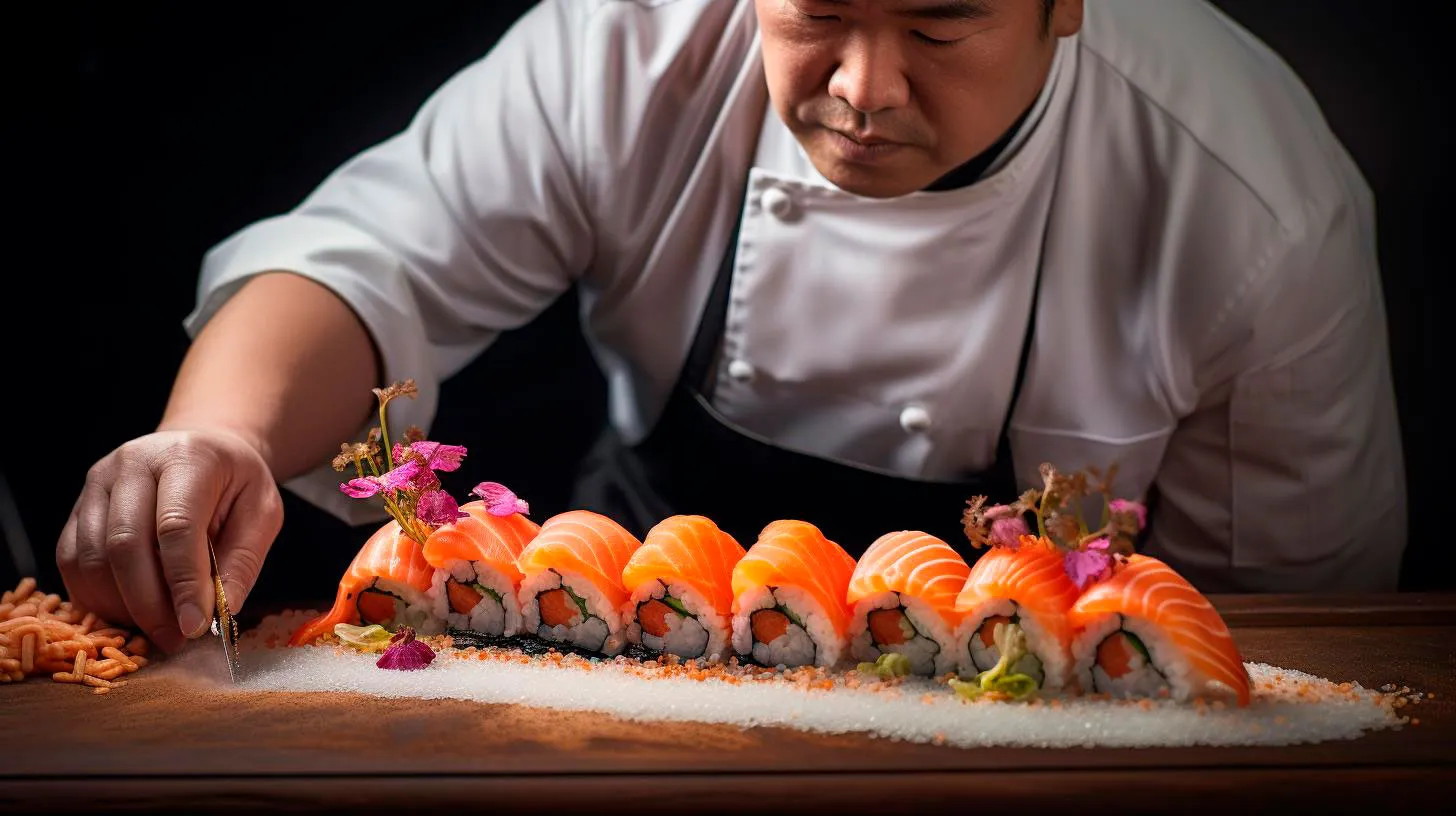Unveiling the Authenticity of Okinawa Sushi
In this article, we will dive into the world of Okinawa sushi and explore its unique qualities that make it a must-try for sushi enthusiasts.
The History and Origins
Okinawa sushi, also known as Ryukyu sushi, traces its roots back to the Ryukyu Kingdom, which existed from the 15th to the 19th century. Okinawa, the southernmost prefecture of Japan, was once an independent kingdom with a distinct culture and cuisine. During this time, Okinawan sushi began to develop, influenced by both Chinese and Japanese cuisines.
As trade between Okinawa, China, and Japan flourished, so did the exchange of culinary techniques and ingredients. The result was Okinawa sushi, a unique blend of flavors and presentation styles that distinguishes it from other types of sushi.
The Key Elements of Okinawa Sushi
Okinawa sushi has several distinctive features that set it apart:
- Strong Umami Flavors: Okinawa sushi is known for its bold flavors, primarily achieved through the generous use of dashi, a savory broth made from dried bonito flakes and kelp. This enhances the umami taste in every bite, creating a flavor sensation.
- Local Ingredients: Being an island prefecture, Okinawa boasts an abundance of fresh seafood, such as tuna, squid, and sea bream. These locally sourced ingredients are the heart and soul of Okinawa sushi.
- Unique Rice Seasoning: While traditional Japanese sushi rice is seasoned with vinegar, sugar, and salt, Okinawa sushi takes a different approach. It utilizes a seasoning called “kurozu,” which is a rice vinegar aged for a longer period, adding a distinct flavor profile.
- Colorful Presentation: Okinawa sushi is famous for its vibrant colors and intricate presentation. Chefs often utilize edible flowers, herbs, and local vegetables to create visually stunning sushi platters that are as pleasing to the eyes as they are to the palate.
The Health Benefits
Aside from its delectable taste, Okinawa sushi offers several health benefits:
- Omega-3 Fatty Acids: The abundance of fresh fish in Okinawa sushi makes it a great source of omega-3 fatty acids, which are essential for heart health and brain function.
- Low in Calories: Compared to other types of sushi that may contain mayonnaise or fried ingredients, Okinawa sushi tends to be lighter and lower in calories. It is a great option for those watching their calorie intake.
- Rich in Antioxidants: Okinawa cuisine, including sushi, often incorporates locally grown vegetables and herbs known for their antioxidant properties. These antioxidants help combat free radicals, promoting overall health and longevity.
Exploring Okinawa’s Sushi Culture
Visiting Okinawa presents the perfect opportunity to immerse oneself in the vibrant sushi culture. Here are some key takeaways:
- Authentic Sushi Restaurants: Okinawa is home to numerous sushi restaurants that showcase the region’s unique sushi style. Dining at one of these establishments allows visitors to experience firsthand the flavors and presentation that make Okinawa sushi so special.
- Sushi Workshops: Many culinary schools and cultural centers in Okinawa offer sushi workshops and classes. These workshops provide participants with the opportunity to learn from skilled chefs and master the art of Okinawa sushi.
- Sushi Festivals: Okinawa hosts various sushi festivals throughout the year, where locals and visitors come together to celebrate this culinary delight. These festivals offer a chance to indulge in a wide array of sushi varieties and witness sushi-making competitions.
The Growing Popularity
In recent years, the popularity of Okinawa sushi has been steadily increasing, both within Japan and beyond. Here are some intriguing statistics:
- In 2019, the number of foreign visitors to Okinawa reached over 10 million, with many seeking an authentic culinary experience.
- Okinawa was ranked as one of the top ten best regions in the world for food by Lonely Planet in 2020, highlighting its unique cuisine, including Okinawa sushi.
In Conclusion
Okinawa sushi is a culinary treasure waiting to be discovered. Its distinct flavors, local ingredients, and vibrant presentation make it a truly unique experience for sushi enthusiasts. Whether you visit Okinawa or find a local restaurant specializing in Okinawa sushi, be sure to indulge in this authentic delight. It’s time to unveil the authenticity of Okinawa sushi and embark on a sensory journey like no other.
Fusion Flavors: The Fascinating Blend of Okinawan and Sushi Traditions
One particular fusion that has gained popularity in recent years is the unique combination of Okinawan and sushi traditions. Let’s dive into this fascinating blend of flavors and discover what makes it so special.
The Unique Characteristics of Okinawan Cuisine
Okinawa, a beautiful island located in southern Japan, boasts a diverse culinary heritage that sets it apart from the rest of the country. Influenced by its historical ties to China, Southeast Asia, and other neighboring countries, Okinawan cuisine combines a variety of flavors, ingredients, and techniques.
- Healthy yet flavorful: Okinawan cuisine is well-known for its emphasis on fresh and healthy ingredients. The island’s residents have one of the highest life expectancies in the world, often attributed to their wholesome, nutrient-rich diet.
- Local ingredients: The use of locally sourced ingredients, such as bitter melon, goya, and purple sweet potato, adds a unique twist to Okinawan dishes. These ingredients are not commonly found in other regions of Japan.
- Rich cultural heritage: Okinawan cuisine reflects the island’s history and cultural influences. From traditional Okinawan stews like goya champuru to unique desserts like sata andagi (Okinawan doughnuts), every dish tells a story.
The Artistry of Sushi
Sushi, on the other hand, is a Japanese culinary art form that focuses on the delicate balance of flavors, textures, and presentation. It originated in Edo-era Japan and has since evolved into a global phenomenon. Here are some key features that make sushi so unique:
- Masterful technique: Sushi chefs spend years honing their craft, perfecting the art of slicing fish, forming rice, and creating beautiful arrangements. Each piece of sushi is meticulously crafted with precision and care.
- Umami explosion: The combination of vinegared rice, fresh seafood, and various toppings creates a harmonious explosion of umami flavors. The subtle balance of ingredients is what distinguishes each sushi roll.
- Healthy and versatile: Sushi is not only delicious, but it can also be a healthy meal option. With a wide variety of choices, from sashimi to vegetable rolls, sushi offers something for everyone.
The Fusion: Okinawan Influence in Sushi
The fusion of Okinawan and sushi traditions brings forth a unique and exciting dining experience. By incorporating elements from both cuisines, chefs have found a way to create dishes that pay homage to tradition while embracing innovation. Here’s what you can expect from this delightful fusion:
- Okinawan-inspired sushi rolls: Chefs often experiment with Okinawan ingredients to create sushi rolls that feature the vibrant flavors of the island. From incorporating goya into maki rolls to using purple sweet potato as a filling, the possibilities are endless.
- Fusion sauces and toppings: To enhance the flavors and add a touch of creativity, chefs may introduce Okinawan-inspired sauces and toppings. Think soy-based sauces infused with unique herbs and spices or garnishes made from local Okinawan vegetables.
- Okinawan-inspired side dishes: Alongside the sushi rolls, you might find Okinawan-inspired side dishes that complement the flavors and add depth to the dining experience. These can include traditional Okinawan stews, pickled vegetables, or unique desserts.
In recent years, fusion sushi establishments that showcase the best of Okinawan and sushi traditions have been popping up around the world. With their innovative menus and creative presentations, these restaurants offer a fresh take on Japanese cuisine.
Key Takeaways: A Fusion Worth Exploring
By blending the flavors and traditions of Okinawa and sushi, chefs have created an entirely new culinary experience. Here are some key takeaways:
- Encounter a unique blend of flavors: The fusion of Okinawan and sushi traditions brings together the vibrant and healthy essence of Okinawa with the artistry and precision of sushi.
- Experience innovative creations: Fusion sushi establishments allow chefs to play with new combinations, resulting in exciting dishes that tantalize your taste buds.
- Discover cultural connections: Through fusion cuisine, you can gain a deeper appreciation for the historical and cultural ties between Okinawa and the rest of Japan.
So, whether you’re a sushi enthusiast, an adventurer seeking new culinary experiences, or simply curious about the rich tapestry of Japanese cuisine, be sure to seek out fusion sushi restaurants that blend the fascinating flavors of Okinawan and sushi traditions. Bon appétit!
Discover the Richness of Okinawa Seafood Cuisine
In this article, we will delve into the captivating world of Okinawa seafood cuisine, exploring its distinctive flavors, health benefits, and key takeaways.
The Flavorful Delights of Okinawa Seafood Cuisine
Okinawa boasts a plethora of flavorful seafood dishes that showcase the region’s vibrant marine biodiversity. Here are some of the highlights:
- Tuna Sashimi: Okinawa is famous for its high-quality, melt-in-your-mouth tuna sashimi. The pristine waters surrounding the islands provide the perfect environment for tuna, resulting in incredibly fresh and delicious slices that are often enjoyed with soy sauce and wasabi.
- Kinmedai: Also known as “splendid alfonsino,” kinmedai is a prized deep-sea fish in Okinawa. Its delicate texture and mildly sweet flavor make it a popular choice for sashimi or grilling.
- Umibudo: Translated as “sea grapes,” umibudo is a type of seaweed found abundantly in Okinawa. With its unique bubble-like appearance and refreshing taste, it is often served as a salad or side dish, adding a delightful crunch to any meal.
- Yaeyama Ishigaki Beef: Although not seafood, Yaeyama Ishigaki beef is worth mentioning due to its exceptional quality. Raised in the verdant pastures of Okinawa’s Ishigaki Island, this premium beef is renowned for its tender texture and unparalleled flavor.
The Health Benefits of Okinawa Seafood
Okinawa’s seafood cuisine not only satisfies your taste buds but also provides several health benefits. Let’s discover the advantages of incorporating Okinawan seafood into your diet:
- Rich in Omega-3 Fatty Acids: Seafood, including tuna and kinmedai, is an excellent source of omega-3 fatty acids. These essential fats have been linked to reducing the risk of heart disease, improving brain function, and promoting overall well-being.
- High in Protein: Seafood is a fantastic source of lean protein, making it an ideal choice for those looking to maintain a balanced diet. Protein supports muscle growth, aids in weight management, and helps repair tissues throughout the body.
- Abundance of Minerals and Vitamins: Okinawa seafood is packed with essential minerals and vitamins, including zinc, selenium, and various B vitamins. These nutrients contribute to a strong immune system, healthy skin, and improved energy levels.
- Low in Saturated Fats: Compared to other meat options, seafood is generally low in saturated fats, which can be detrimental to cardiovascular health. Choosing seafood as a protein source can help maintain a healthy cholesterol level and reduce the risk of heart-related ailments.
Key Takeaways for Seafood Enthusiasts
If you find yourself in Okinawa or have the opportunity to try Okinawan seafood cuisine, remember these key takeaways:
- Okinawa’s seafood cuisine offers a wide range of flavorful delights, including tuna sashimi, kinmedai, umibudo, and Yaeyama Ishigaki beef.
- Incorporating Okinawan seafood into your diet can provide you with numerous health benefits, such as omega-3 fatty acids, high-quality protein, essential minerals, and vitamins.
- Seafood offers a healthier alternative to meat, as it is generally low in saturated fats and contributes to a well-rounded diet.
Immerse yourself in the richness of Okinawa’s seafood cuisine and indulge in the fresh flavors and health benefits it has to offer. Whether you are a seafood enthusiast or looking to explore new culinary horizons, Okinawa is sure to delight your palate with its mouthwatering creations.
Exploring Okinawan Elements in Exquisite Sushi Creations
Okinawa, a group of islands in Japan, boasts its own distinct culture, cuisine, and ingredients that are now finding their way into sushi dishes. In this article, we will explore the incorporation of Okinawan elements in exquisite sushi creations and the delightful culinary experience they offer.
The Okinawan Influence in Sushi
Okinawan cuisine is known for its diverse flavors, incorporating influences from China, Southeast Asia, and Japan. The island’s abundance of fresh seafood and unique locally sourced ingredients allows for the creation of sushi dishes that both surprise and satisfy the palate. Sushi chefs have embraced the Okinawan culinary heritage, pushing the boundaries of traditional sushi recipes and techniques to create extraordinary sushi masterpieces.
1. Island-Inspired Ingredients
Okinawa’s fertile land and surrounding ocean provide an array of ingredients that add a distinct taste to sushi creations:
- Sea Grapes: Known as “umibudo,” these tiny green seaweed pearls explode with a refreshing, oceanic burst that complements the delicate flavors of sushi.
- Goya: The bitter melon known as goya is used in Okinawan cuisine to balance flavors. When thinly sliced and incorporated into sushi rolls, it adds a unique bitter note.
- Purple Sweet Potato: With its vibrant color and natural sweetness, purple sweet potato is often used as a sushi topping, providing an interesting visual contrast and flavor profile.
- Shikuwasa: This citrus fruit native to Okinawa has a tart and tangy flavor. Squeezing its juice over sushi can enhance the taste and provide a refreshing sensation.
2. Fusion of Flavors
The infusion of Okinawan elements into sushi allows for the creation of unique flavor profiles that tantalize the taste buds:
- Kombucha: Okinawan-style sushi often features kombucha, a type of seaweed that adds a subtle briny taste, elevating the umami flavors characteristic of sushi.
- Pork Belly: While not a traditional sushi ingredient, the use of slow-cooked, tender pork belly in Okinawan sushi adds richness and a savory touch, creating a fusion of flavors.
- Awamori-Infused Soy Sauce: Awamori, a distilled Okinawan liquor, is sometimes used to infuse soy sauce, bringing a unique sweetness and depth of flavor to sushi dipping sauces.
Key Takeaways for Sushi Lovers
Exploring Okinawan elements in sushi opens up a whole new world of flavors and experiences for sushi lovers. Here are some key takeaways:
- Okinawan-inspired sushi offers a unique fusion of flavors, ranging from refreshing ocean bursts to subtle bitter notes.
- Locally sourced ingredients such as sea grapes, goya, and purple sweet potato add visual appeal and distinct tastes to sushi rolls.
- Infusing sushi with Okinawan elements allows for the discovery of new taste combinations, creating a delightful culinary adventure.
As sushi continues to evolve and embrace various regional influences, the exploration of Okinawan elements opens up exciting possibilities for sushi enthusiasts and chefs alike. The marriage of traditional sushi techniques with Okinawan flavors creates a truly exquisite culinary experience that showcases the rich cultural heritage of Japan. So, next time you indulge in sushi, dare to explore the Okinawan elements and embark on a delectable journey of flavors.



